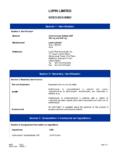Transcription of Valudor Products - Brandt Home Page
1 Valudor Products MATERIAL SAFETY DATA SHEET. product Name Magnesium Sulfate Heptahydrate Supplier Valudor Products 1728 Hawk View Drive Encinitas, CA 92024. Telephone (760) 635 9051. Emergency Telephone 1 (800) CHEMTRAC. product IDENTIFICATION. product Name Valumag 7. Molecular Formula MnSO4 7H20. CAS Number 7487-88-9. PHYSICAL PROPERTIES. Appearance Transparent crystals Odor No Odor Melting Point 2055F. Solubility in Water Highly soluble in water HEALTH HAZARD INFORMATION. Skin No adverse effects expected but may cause minor skin irritation. Eyes No adverse effects expected but dust may cause mechanical irritation. Inhalation Dust may be slightly irritating. Sore throat or coughing may occur. Swallowing Since magnesium salts are slowly absorbed, abdominal pain, vomiting and diarrhea may be the only symptoms. However, if elimination is blocked by bowel blockage or other reasons, CNS depression, lack of reflexes, hypocalcemia (deficiency of calcium in the blood) may occur.
2 1. FIRE AND EXPLOSION HAZARD INFORMATION. Not considered to be a fire or explosion hazard. Flash Point Not applicable. Flammable Limits Not flammable. Extinguishing Media Use any means suitable for extinguishing surrounding fire. REACTIVITY DATA. Stability Stable under ordinary conditions of use and storage. Hazardous Decomposition Oxides of sulfur and the contained metal. Products Polymerization Will not occur. Incompatibilities Phosphates, ethoxy ethyl alcohols, tartrates, alkali metals. FIRST AID MEASURES. Swallowing Give several glasses of water to drink to dilute. If large amounts were swallowed, get medical advice. Skin Remove any contaminated clothing. Wash skin with soap and water for at least 15 minutes. Get medical attention if irritation develops or persists. Eyes Wash thoroughly with running water. Get medical advice if irritation develops.
3 Inhalation Remove to fresh air. Get medical attention for any breathing difficulty. Note to Physician IV administration of calcium gluconate will partially reverse the effects of acute magnesium toxicity. Ventricular support with calcium chloride infusion and mannitol forced diuresis has also been successful. EXPOSURE CONTROLS AND PERSONAL PROTECTION INFORMATION. Personal Protective Equipment Skin Protection: Wear protective gloves and clean body-covering clothing. Eye Protection: Use chemical safety goggles. Maintain eye wash fountain and quick-drench facilities in work area. Ventilation A system of local and/or general exhaust is recommended to keep employee exposures as low as possible. Local exhaust ventilation is generally preferred because it can control the emissions of the contaminant at its source, preventing dispersion of it into the general work area.
4 Please refer to the ACGIH document, Industrial Ventilation, A Manual of Recommended Practices, most recent edition, for details. 2. For conditions of use where exposure to dust or mist is apparent and engineering controls are not feasible, a particulate respirator (NIOSH. type N95 or better filters) may be worn. If oil particles ( lubricants, cutting fluids, glycerine, etc.) are present, use a NIOSH. type R or P filter. For emergencies or instances where the exposure levels are not known, use a full-face positive-pressure, air-supplied respirator. WARNING: Air-purifying respirators do not protect workers in oxygen-deficient atmospheres. Airborne Exposure Limits: None established. ENVIRONMENTAL AND DISPOSAL INFORMATION. Waste Disposal Whatever cannot be saved for recovery or recycling should be managed in an appropriate and approved waste disposal facility.
5 Processing, use or contamination of this product may change the waste management options. State and local disposal regulations may differ from federal disposal regulations. Dispose of container and unused contents in accordance with federal, state and local requirements. Environmental Effects No information found. TOXICOLOGICAL INFORMATION. No LD50/LC50 information found relating to normal routes of occupational exposure. REGULATORY INFORMATION. Chemical Weapons Convention: No TSCA 12(b): No CDTA: No SARA 311/312: Acute: Yes Chronic: Yes Fire: No Pressure: No SARA 302: No SHIPPING INFORMATION. Not regulated. NPFA RATINGS: Health: 1. Flammability: 0. Reactivity: 0. All information in this MSDS was obtained form sources we believe are reliable. However, the information is provided without any warranty or representation, expressed or implied, regarding its accuracy.
6 3.







